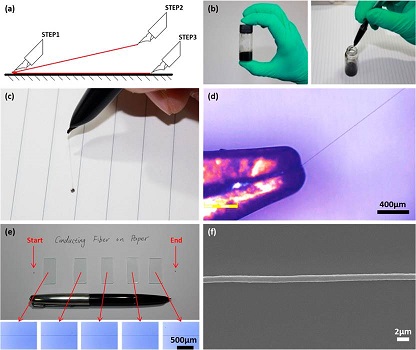Although there are many potential applications for carbon nanotubes (CNTs), their wide scale consumer applications to date have been limited to serving as polymer additives to yield higher-strength composites. Even though bulk nanotubes exhibit tensile strengths much less than individual nanotubes (especially single-walled varieties), bulk CNT additives have been shown to enhance the strength:weight ratio of a variety of sporting equipment such as bicycles, skies, baseball bats, hunting arrows, and surfboards.
Beyond their high-strength properties, the extraordinary electrical conductivity of CNTs makes these nanostructures ideal for microelectronics circuitry applications. Using advanced techniques such as near-field electrospinning (NFES), it is now possible to generate conductive nanotube fibers that span up to a few hundred meters. However, current fiber processing techniques are difficult to scale up, and often experience difficulties with nanotube alignment during fiber spinning. This latter limitation is an important consideration for microelectronics applications, since unaligned nanotubes would deleteriously affect the conductivity of the deposited fibers.

Patterning consists of using poly(ethylene oxide), PEO, in the presence of surfactants and carbon nanotubes, which forms a polymeric ‘ink’. The choice of PEO was due to its desirable viscoelastic properties, which allowed for the continuous pulling of fibers from the solution without breakage. In contrast, fibers drawn from solutions of poly(methyl methacrylate), PMMA, commonly used in other patterning techniques, have much larger diameters and inconsistent conductivities due to less effective alignment of nanotubes comprising the fiber. Whereas PEO in the absence of CNTs dried to form nanofibers with diameters of ca. 60 nm, the diameter range of PEO-CNT composite fibers was ca. 300 nm – 3 mm. One is able to vary the diameter of the composite PEO-CNT fibers, based on the solution concentration and volume used in the pen tip.
Fiber lengths in excess of 50 cm were achieved using this technique, and featured a high degree of nanotube alignment – especially for low-diameter fibers. Consequently, the conductivity of the fibers were significantly higher than isotropic CNT thin films. In contrast to other techniques that require the use of micro/nanomanipulators to appropriately position fibers into electronic circuitry, this direct-writing procedure is able to place the conductive fibers directly into desired positions with submicron control. The fibers may also be transferred to other substrates after drying without changing their morphologies or electrical conductivities.
With a surge in flexible and wearable electronic devices on the horizon, it is essential that techniques exist for the fabrication of flexible conductive wires. This work represents an attractive strategy, and results in fibers that may be easily fabricated using a common pen tip and placed onto a variety of surfaces. Furthermore, the conductivity of the fibers is not altered by repeated bending tests, which should enable this technique to be used for the next generation of flexible touchscreens, wearable electronics, and the batteries or supercapacitors that will be needed to power these devices. Further testing is needed to assess the adsorption of the PEO-CNT fibers to textiles, LCDs, and other surfaces. However, this technique shows promise for the fast assembly and precise placement of conductive fibers into electronic circuits.
Reference: Huang S, Zhao C, Pan W, Wu H. Direct Writing of Half-Meter Long CNT Based Fiber for Flexible Electronics. Nano Letters. 2015; 15 (3): 1609-1614 doi: 10.1021/nl504150a
Image reprinted with permission from American Chemical Society.
